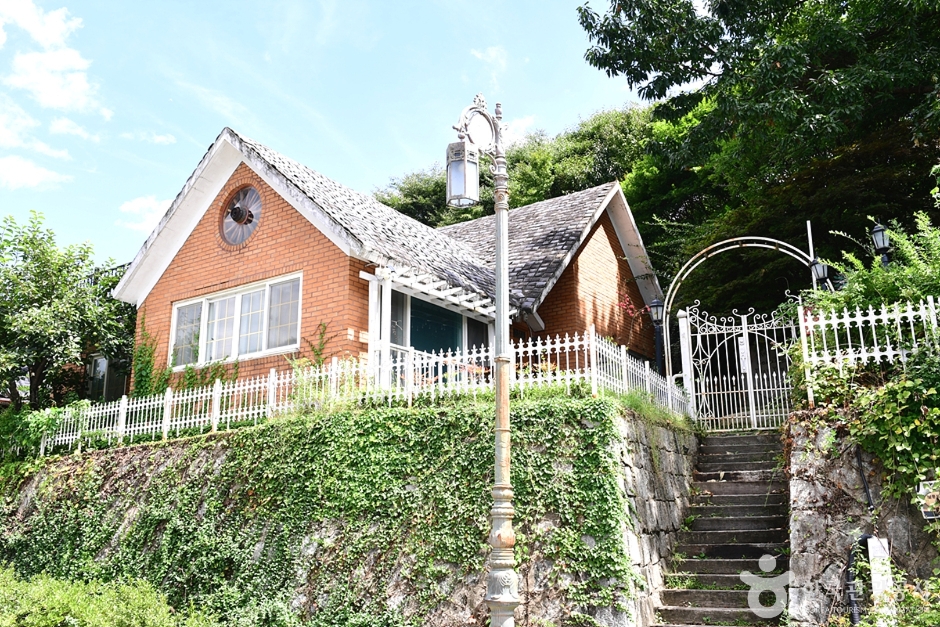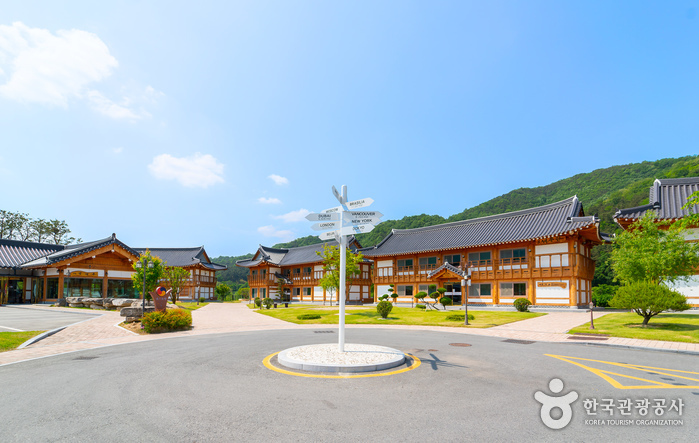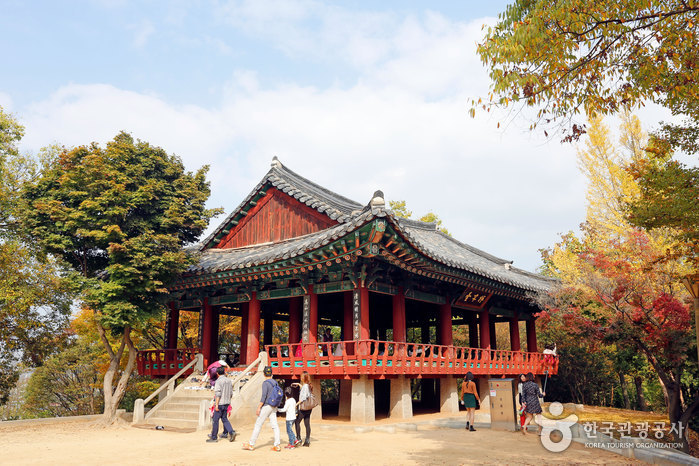Taejonggwan of the Royal Room [Korea Quality] / 왕의지밀 태종관 [한국관광 품질인증/Korea Quality]
1.2Km 2024-04-07
5218-24, Chunhyang-ro, Wansan-gu, Jeonju-si, Région Jeonbuk
+82-63-284-1004
The Royal Room is a hanok (traditional Korean house) hotel encapsulating Jeonju’s spirit as a city of tradition and art, and the exemplar of the state of Joseon. The hanok buildings are built next to one another on a plot spanning 19,840 m2 in Daeseong-dong, inspired by the unique elegance and understated extravagance of Joseon’s royal culture.
11 residential buildings are all named after the kings of the Joseon Dynasty. Taejonggwan is one of them, containing six rooms in total. Each room is a self-contained unit made up of bedrooms and restrooms, furnished with a combination of hanok’s unique charms and modern comfort. The view of the wooden exposed beams, paintings on the wall, and the view of nature beyond the window wall recreate the unique scenery of the hanok. All rooms are also equipped with modern comforts such as wireless Internet, TV, refrigerator, and air conditioning.
The hotel has about 150 parking spots, a hanok cafe, and theConvention Center with spaces designed for large meetings and events. Samtaegeuk and Samjogo Restaurants are designated as COVID-19 Safe Restaurants by the city of Jeonju. The hotel is located about 7 min by car to Jeonju Hanok Village, and is close to other famous sights such as Jeondong Catholic Cathedral, Gyeonggijeon Shrine, and Jeonjuhyanggyo Local Confucian School, which make ideal half-day trip destinations.
Maison 2521, prononcée « i-o-i-il » (이오이일)
1.2Km 2025-08-12
5-19, rue Omokdae, Wansan-gu, Jeonju, province autonome spéciale de Jeonbuk (Gyodong)
2521 est un hébergement indépendant situé au cœur du village hanok de Jeonju. Il s’agit également de la maison du personnage principal Na Hee-do dans le drama Vingt-cinq, vingt-et-un. Lors de la réservation, le propriétaire peut installer des accessoires identiques à ceux utilisés dans la série.
Les clients peuvent profiter d’un barbecue dans la cour et admirer la vue panoramique du village hanok depuis la terrasse sur le toit. L’hébergement peut accueillir jusqu’à huit personnes.
Sejonggwan of the Royal Room / 왕의지밀 세종관
1.2Km 2025-08-12
5218-22, Chunhyang-ro, Wansan-gu, Jeonju-si, Région Jeonbuk
+82-63-284-1004
This hanok (traditional Korean house) hotel is located near Jeonju Hanok Village. The hotel has enjoyed great popularity among the tourists visiting Jeonju since its opening in 2018, for its convenient location of only a 7-min drive away from Jeonju Hanok Village and its faithful recreation of hanok’s beauty with modern sensibilities. The hotel complex stands on a plot of land spanning 19,840 m2, containing 11 residential buildings and other facilities. As the name of the hotel indicates, each building in the hotel is named after the kings of the Joseon Dynasty.
Sejonggwan is named after King Sejong. Sejonggwan has eight rooms, divided between Gold and Silver Rooms. Each room is a self-contained unit made up of bedrooms and restrooms, furnished with a combination of hanok’s unique charms and modern comfort. The view of the wooden exposed beams (Gold Room), paintings on the wall, and the view of the nature beyond the window wall recreate the unique scenery of the hanok, while amenities such as TV, refrigerator, and air conditioning offer a comfortable stay.
Other facilities inside the hotel complex include the spacious parking lot, an elegant hanok cafe, and the Convention Center, housing family-size Daejanggeum Hall and Hunminjeongeum Hall, a large hall suited for seminars. It takes only 10 min by car to reach any tourist sites near Jeonju Hanok Village from the hotel.
Munjonggwan of the Royal Room [Korea Quality] / 왕의지밀 문종관 [한국관광 품질인증/Korea Quality]
1.2Km 2024-04-07
5218-20, Chunhyang-ro, Wansan-gu, Jeonju-si, Région Jeonbuk
+82-63-284-1004
This hanok hotel combines the unique aesthetics of hanok (traditional Korean house) and modern amenities. It is located close to Jeonju Hanok Village and offers excellent access to nearby tourist sites. 14 hanok buildings are located upon a plot of land spanning 1,9840 m2. Each of the 11 buildings is named after the kings of the Joseon Dynasty, which is reflected in the name of the hotel, “Royal Room.” The hotel invokes Jeonju’s status as the historic origin of the Joseon Dynasty and an exemplar of its culture.
Munjonggwan, one of the 11 buildings in the complex, has eight rooms, divided between Gold and Silver Rooms. Each room is a self-contained unit made up of bedrooms and restrooms, furnished with the unique comfort of hanok. The view of the wooden exposed beams (Gold Room) and chirping insects beyond the window wall create an experience that can only be had in the Royal Room.
The hotel has about 150 parking spots, a hanok cafe, and a Convention Center with spaces such as Daejanggeum Hall, Saimdang Hall, Chungmugong Hall, and Hunminjeongeum Hall. Samtaegeuk and Samjogo Restaurants are designated as COVID-19 Safe Restaurants by the city of Jeonju. The hotel is located about 7 min by car to Jeonju Hanok Village, and is close to other famous sights such as Jeondong Catholic Cathedral and Gyeonggijeon Shrine.
Sejogwan of the Royal Room [Korea Quality] / 왕의지밀 세조관 [한국관광 품질인증/Korea Quality]
1.3Km 2024-04-07
5218-18, Chunhyang-ro, Wansan-gu, Jeonju-si, Région Jeonbuk
+82-63-284-1004
This is a premium hanok (traditional Korean house) hotel located near Jeonju Hanok Village. As evident from its name, the hotel promises a comfortable stay in a hanok since its opening in 2018. The hanok buildings are built next to one another on a plot spanning 19,840 m2. Each of the 11 buildings is named after the kings of the Joseon Dynasty.
Sejogwan, one of the 11 building, has six rooms, divided between Gold and Silver Rooms. All rooms are furnished with beds, and combine modern comfort with traditional sensibilities. Wooden exposed beams (Gold Room) and window wall facing the scenery outside recreate the unique beauty of hanok, while amenities such as TV, refrigerator, and air conditioning offer a comfortable stay.
The hotel has about 150 parking spots, a hanok cafe, and the Convention Center with spaces such as Daejanggeum Hall, Saimdang Hall, Chungmugong Hall, and Hunminjeongeum Hall. Restaurants such as Samtaegeuk Restaurant, the site of the hotel’s breakfast offering, and Samjogo Restaurant, a Korean restaurant serving lunch and dinnertime, are designated as COVID-19 Safe Restaurants by the city of Jeonju. The hotel is located about 7 min by car to Jeonju Hanok Village, and is close to other famous sights such as Jeondong Catholic Cathedral, Gyeonggijeon Shrine, and Jeonjuhyanggyo Local Confucian School.
Omokdae et Imokdae (오목대와 이목대)
1.3Km 2025-08-12
1-3, Gyodong 1-ga, Wansan-gu, Jeonju-si, Région Jeonbuk
+82-63-281-2114
Omokdae, situé en haut d'une colline est le lieu où Yi Seong-gye (qui devint plus tard le Roi Taejo) s'arreta pour célébrer sa victoire lors d'une bataille contre l'armée japonaise au Mont Hwangsan à Unbong vers la fin de la période Goryeo. C'est aussi là où Mokjo, l'un des ancêtres de Yi Seong-gye, vécut. Plus tard, le Roi Gojong y établit une statue monumentale, “Taejogohwang Jejupilyujibi” avec une phrase écrite de sa propre main. De l'autre côté de Yukgyo, à partir d'Omokdae, se trouve Yimokdae, au pied du Mont Seungamsan où Chimyeongjasan, sité sacré pour les catholiques demeure. A 80 m de Yimokdae se trouvent un mémorial et une maison. “Mokjodaewang Gugeoyuji”, la phrase gravée sur le monument en pierre, fut écrite par le Roi Gojong en personne. Mokjo est le cinquième ancêtre du Roi Taejo, qui fonda la Dynastie Joseon. Imokdae est connue pour être le lieu où Mokjo vécut, jouant à des jeux de formation de bataille avec ses amis étant enfant. Cette anecdote apparait également dans le Yongbieocheonga (ballade du 15e siècle narrant la longévité nationale et la réussite culturelle). Mokjo se rendit à Hamgyeong-do à partir d'Imokdae (à Jeonju) en raison de la querelle qu'il eut avec le Jeonju Busan (officiel de l'etat gouvernant la région de Jeonju). Yi Seong-gye pensa que le départ de Mokjo était quelque chose ayant été guidé par les dieux afin qu'il (Yi Seong-gye) puisse fonder Joseon et devenir le premier roi de la dynastie.
Seonjogwan of the Royal Room [Korea Quality] / 왕의지밀 선조관 [한국관광 품질인증/Korea Quality]
1.3Km 2024-04-07
5218-16, Chunhyang-ro, Wansan-gu, Jeonju-si, Région Jeonbuk
+82-63-284-1004
This modern hanok (traditional Korean house) hotel is located about 7 min by car to Jeonju Hanok Village. It is best known for its seamless combination of the unique aesthetics of hanok’s beauty and modern comfort. Like its name, the Royal Room is a hanok hotel encapsulating Jeonju’s spirit as a city of tradition and art, and the exemplar of the state of Joseon. The hotel complex stands on a plot of land spanning 19,840 m2, containing 14 hanok buildings that blend elegantly with the beautiful scenery nearby.
Its 11 residential buildings are all named after the kings of the Joseon Dynasty, and the same goes for Seonjogwan. Seonjogwan has six rooms, consisting of Grade 2 Gold and Silver Rooms, Grade 3 Gold and Silver Rooms, and Grade 5 Gold and Silver Rooms. Gold Rooms are located on the second floor, while the 1st floor is occupied by the Silver Rooms. There are no elevators in the building, so elderly guests are recommended to choose the Silver Rooms on the first floor.
The two hanok restaurants on the premise, Samtaegeuk and Samjogo Restaurant, are designated as COVID-19 Safe Restaurants by the city of Jeonju. The hotel has about 150 parking spots, a hanok cafe, and the Convention Center with spaces such as Daejanggeum Hall, Saimdang Hall, Chungmugong Hall, and Hunminjeongeum Hall. It takes only 10 min by car to reach most tourist sites in Jeonju.
Gyo Dong Sal Rae [Korea Quality] / 교동살래 [한국관광 품질인증]
1.3Km 2024-04-07
66-1, Jeonjucheondong-ro, Wansan-gu, Jeonju-si, Région Jeonbuk
+82-10-9043-6743
Located at the entrance to Namcheongyo Bridge, which flows over Jeonjucheon Stream, Gyodongsalrae is a hanok structure built in 1971. It consists of the sarangchae (men’s quarters), anchae (women’s quarters), and byeolchae (detached House) and has ten guestrooms in total. While the sarangchae is situated near the road, the anchae and byeolchae are located to the rear of the house. Each building has a well-maintained flowerbed filled with seasonal flowers that harmonize perfectly with the beauty of the hanok.
The interior of the house is decorated with a variety of antiques, paintings, embroidery and knitting works, creating a cozy atmosphere. The ten rooms are of different sizes and styles including an ondol (Korean floor heating system) room, a room with a bed, and a darak (garret) room. The sarangchae consists of the Changpobang, Maehwabang, Baerongbang and Mokryeonbang rooms, of which the last two have a terrace with an open view. The anchae consists of a living room (sarangbang) and a room for two people. The byeolchae with a small courtyard has three large rooms with a capacity of four to six people and a separate space for relaxation and breakfast.
Yangsajae [Korea Quality] / 문화공간 양사재 [한국관광 품질인증]
1.3Km 2024-04-07
40, Omokdae-gil, Wansan-gu, Jeonju-si, Région Jeonbuk
+82-63-282-4959
Located in Jeonju Hanok Village, Yangsajae was the place where the poet Lee Byeong-gi (pen-name: Garam, sijo poet) composed his sijo (a Korean traditional poetic form) works. Now used as a cultural space, the house attracts many people looking for relaxation and cultural experiences.
Yangsajae, meaning “a house (jae) that cultivates (yang) classical scholars (sa)”, was an annex of the Jeonjuhyanggyo Confucian School where classical scholars used to study in preparation for the national civil service examinations. As an educational and creative place, Lee Byeong-gi composed sijo poems there for six years from 1951. It later served as the Jeonbuk Public Elementary School with the introduction of new learning to the Jeollabuk-do area in 1987. Since 2002, however, it has served as a hanok stay dedicated to promoting local history and traditions to the public. It is said that the building was constructed on a 400-year-old site about 150 years ago. In 1980, repair work was conducted to save the basic structure of the house.
The house is a typical ‘ㄱ’-shaped hanok structure with a half-hipped roof. In particular, the three dormitory rooms originally used by Confucian students and classical scholars can be converted into one single room for seminars, tea ceremonies, or other group meetings simply by opening the bunhapmun (sliding doors).
The guesthouse is a ‘ㅡ’-shaped hanok built in 1980. Each room has a clean and cozy interior with simple decoration and furniture. The rooms include the Gudeul (floor heated with firewood) Room, where the tea ceremony program using green tea leaves picked from the wild green tea field behind the house is held, and the Ondol (Korean floor heating system) Room.
As the poet Lee, who loved orchids, poems and alcohol, lived at Yangsajae, there are still traces of his former presence inside the house. Notably, Lee used the ‘Garamdasil’ room as his study room, so it displays some of his photos.
There is a postbox situated in a corner of the yard which the guests can use, and the owner will deliver the mail himself. Yangsajae is not only a hanok accommodation but also a multi-experience space where guests can discover traces of the old educational institute and the poet Lee’s life and works.
Pont Namcheongyo (남천교 청연루)
1.3Km 2024-04-24
40, Cheongyeong-ro, Wansan-gu, Jeonju-si, région Jeonbuk
Le pont Namcheongyo est le principal pont pour entrer dans le village des hanok de Jeonju. Avec le projet dénommé "Jeonju Namcheongyo Luxury Project", la zone a connu des rénovations pour renforcer la structure et ajouter le pavillon Cheongyeonru.
Les visiteurs peuvent apprécier une vue panoramique de la zone depuis le pavillon hanok ou se reposer à l'abri de la chaleur en été.
![Taejonggwan of the Royal Room [Korea Quality] / 왕의지밀 태종관 [한국관광 품질인증/Korea Quality]](http://tong.visitkorea.or.kr/cms/resource/30/2705930_image2_1.jpg)


![Munjonggwan of the Royal Room [Korea Quality] / 왕의지밀 문종관 [한국관광 품질인증/Korea Quality]](http://tong.visitkorea.or.kr/cms/resource/18/2705918_image2_1.jpg)
![Sejogwan of the Royal Room [Korea Quality] / 왕의지밀 세조관 [한국관광 품질인증/Korea Quality]](http://tong.visitkorea.or.kr/cms/resource/13/2705913_image2_1.jpg)

![Seonjogwan of the Royal Room [Korea Quality] / 왕의지밀 선조관 [한국관광 품질인증/Korea Quality]](http://tong.visitkorea.or.kr/cms/resource/51/2705951_image2_1.jpg)
![Gyo Dong Sal Rae [Korea Quality] / 교동살래 [한국관광 품질인증]](http://tong.visitkorea.or.kr/cms/resource/71/2556371_image2_1.jpg)
![Yangsajae [Korea Quality] / 문화공간 양사재 [한국관광 품질인증]](http://tong.visitkorea.or.kr/cms/resource/75/1879875_image2_1.jpg)

 Français
Français
 한국어
한국어 English
English 日本語
日本語 中文(简体)
中文(简体) Deutsch
Deutsch Español
Español Русский
Русский